Search results
56 results found.
56 results found.
There are many things, I admit it, that deeply fascinate me about Turkey and one of them is its complicated linkage over the centuries with Venice. Polar opposites, one might think, until one begins to look closer.
As I was expatiating on this theme recently, I neglected to mention a few of the manifestations of this linkage lurking here. And one of them does not show Venice in her best light.
First: Two steps from Campo San Barnaba is a short, narrow street (with bridge) named the Calle (and Ponte) de le Turchette. If you were to guess, based on your elementary Italian, that this means “Street of the Little Turkish Girls,” you would be right.
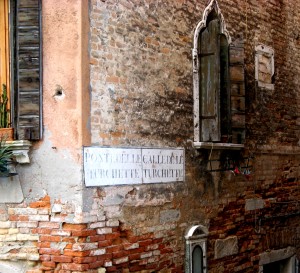 Tradition maintains that in the era before the Casa dei Catechumeni was established to accommodate instruction in the Roman Catholic faith, there was a house here where Turkish women (“Turchette”), taken prisoner in assorted battles, were kept. Their time was spent mainly in being converted to Christianity. Or not. No word on the rate of conversion, or whether conversion was considered optional, or what the consequences were for not converting, at least not by the point where I stopped seeking information.
Tradition maintains that in the era before the Casa dei Catechumeni was established to accommodate instruction in the Roman Catholic faith, there was a house here where Turkish women (“Turchette”), taken prisoner in assorted battles, were kept. Their time was spent mainly in being converted to Christianity. Or not. No word on the rate of conversion, or whether conversion was considered optional, or what the consequences were for not converting, at least not by the point where I stopped seeking information.
According to the estimable Giuseppe Tassini, writing in Curiosita’ Veneziane, a document in the Scuola di San Rocco states that the confraternity possesses a house in the parish of San Barnaba, “in Calle Longa, where the Turchette are housed.” That’s all I can tell you about this, though every time I pass this way I admit that images of exotic females, enclosed in another sort of harem, wander through my mind.
Second: An even more intriguing Middle-Eastern, let’s say, element is a mute patera (PAH-teh-ra) affixed to the side of a house behind the former hospital of the Incurabili. (These “incurables” were mostly syphilitics, if you’re wondering.)
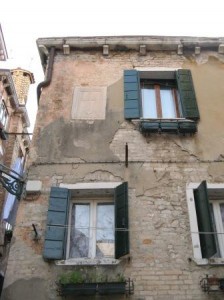
Patere were typically circular plaques carved in low relief on Istrian stone, often showing animals, which were placed on buildings generally from the 10th to the 12th century, though a few date till the 15th. These images were intended to ward off evil.
The one that fascinates me, though, has a very different vibe. It shows a cross, whose base is in the suggested form of a sword, standing upon a crescent.
The conclusions one might draw from this are fairly obvious, but that’s what annoys me — because so often the obvious turns out to be excitingly wrong. There is also the curious factor of the points of this crescent not being identical. So far, however, I haven’t been able to learn anything about it. But there it is.
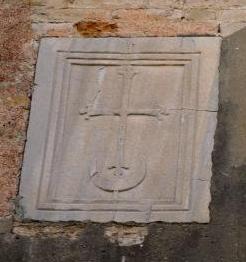
A small digression on Turkishness: Ever since maize began to come to Italy from the Americas in the 1500’s, it has borne the name granoturco, or Turkish grain. There are various hypotheses for this, none of them definitive, but one of the more credible ones refers to the custom of lumping all sorts of foreign things together under the generic label “Turkish.” A relic of this habit applies here today regarding the Slavic women who come from Eastern Europe to work as caretakers of the elderly; even though they may come from Ukraine, Romania, or Moldova, I’ve heard at least a few Venetians refer to them as “Turche.”
Now we come to a longish street whose official name is “Barbarie de le Tole,” but which I think of as the “Street of the Kebab Joints.” And here the theme of Turkishness becomes less attractive.
There are some 20,000 students in Venice, a total of the enrollments in the two universities (Ca’ Foscari, the University of Venice, and the I.U.A.V., or University of Architecture). There is also a noticeable number of immigrants in the city, some from the Middle East or North Africa. And there is also a growing group of tourists who are getting by on a squeaking budget. These are all people who typically seek nourishing and/or good food at a very small price. So from pizza-by-the-slice (Italian, even if not very civilized), the choice has broadened out to include doner kebab, or what in the U.S. is often called by its Greek name, gyros. Foreign. Suddenly this changes things.
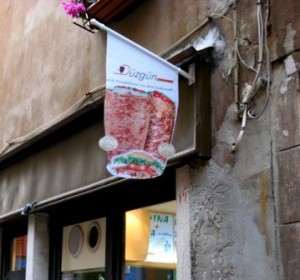
Doner kebab was invented in Erzurum, eastern Turkey, and since the Seventies it has become a common and familiar fast food in most European countries. The making and selling of it are virtually always in the hands of Turkish individuals.
But all of a sudden Venice isn’t happy with these little places. I can’t say whether the kebabs’ precursors were available in the declining years of the Venetian Republic, but considering the spectacular variety of ethnicities and creeds which were to be found milling around the streets and markets and waterfronts of Venice back in the Old Days, it wouldn’t surprise me.
In the past decade or so, the subject of immigration (to Europe, not only to Venice) has become an increasingly tormented one politically, economically, and socially. Considering the multi-cultural foundation of this town, any anti-foreign sentiment is in some ways difficult to justify — not that one can’t understand it. This is a theme which I will dissect at another time.
But on December 4, the Gazzettino announced that the mayor has signed an ordinance forbidding the granting of any new licenses for kebab joints until 2012. The reasons given for this are many; they bob like ornaments hanging on a tree which has been hollowed by termites. The reasons as stated are:
And who proposed this extraordinary measure? Not any of the assorted Superintendents of the Artistic/Historic/Cultural/Archaeological Heritage; nor the director of the Academy of Fine Arts, nor the Guggenheim Collection, nor anyone from the battalions of professors of art, history, or even tourism, if you will, though any of those protagonists might be able to make a reasonable case. Not a voice from the syndics of the Venice Atheneaum. Nobody from any sphere or stratum of the cultural or artistic universe here. Not even a wail from Augusto Salvadori, the City Councilor for Tourism and Protection of Traditions and Decorum.
Despite its being couched in cultural and historic and artistic terms, the proposal was in fact made by Giuseppe Bortolussi, the plain old City Councilor for Productive Activity and Commerce. Therefore one can interpret these cultural concerns in economic terms, in favor of the small businessmen who are the competitors of the kebabists.
And the decree will cover 13 of the 24 most important touristic points of the city, including the Rialto, the area of San Marco (where there is already a flourishing McDonald’s), the train station, and the Accademia. They might just as well have said “everywhere,” considering that they have stated that there are already enough such places to satisfy the demand.
I thought capitalism posited that the consumers, not the city councilors, were the ones who get to decide which businesses live and which die. And if it’s possible to determine at what point there are “enough” kebab joints, it ought to be possible to determine at what point there are “enough” shops selling glass and Carnival masks, which a stroll around the city reveals as being somewhere around 249,327. Enabling infinite choice in souvenirs (good!) doesn’t seem to translate into infinite choice in foodstuffs (not good!).
This ordinance looks strangely like an effort to protect the restaurateurs, not the city, from impoverishment. To herd the wandering tourist seeking sustenance back into the trattorias and restaurants where the prices can sometimes go so high, at least compared to the value received, that they practically glow in the dark.
But I’d like to close this little cultural pilgrimage with the observation that hypocrisy evidently provides more fertile terrain than volcano slopes after an eruption if you want to grow a bumper crop of contradictions. All those affirmations of protecting the artistic and historic nature of the city? One hardly knows where to start to list the examples of how that concept has been violated.
I’ll provide just a few random snaps, chosen mainly by their convenience. Anyone who can explain why these alterations are permissible (I’ll spare you the details of the laws designed to “protect” the artistic and architectural nature of the city) is eagerly invited to enlighten me.
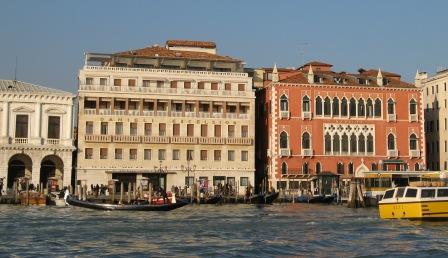
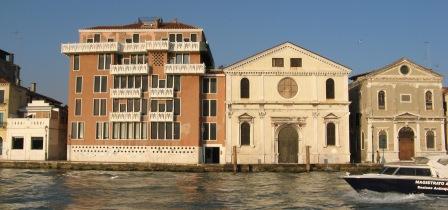
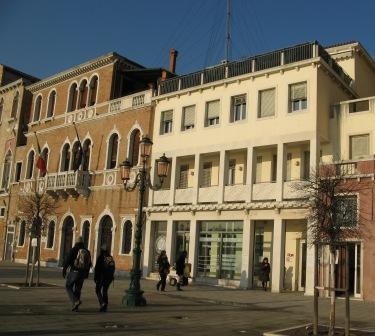
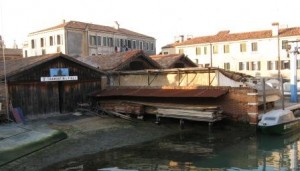
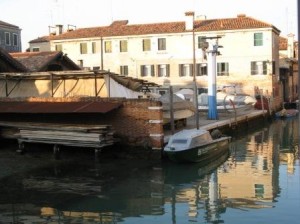
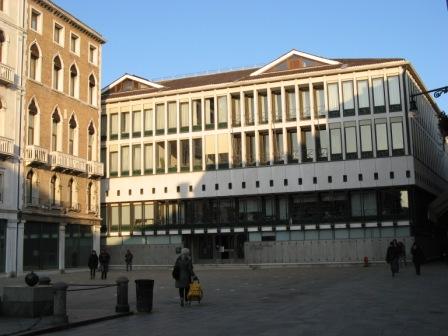
“No ghe xe schei” (No ghe zeh skay). It means “There is no money,” in Venetian, and it’s a phrase one hears all too often.
If Venice were to have a soundtrack, it wouldn’t be the shimmering arpeggios of Vivaldi or Marcello, it would be this monotonous lament. The statement obviously refers to the state of the municipal coffers, but it’s an extremely versatile and handy tool. It can be used either as a weapon of attack or defense, and is also useful as an accusation. It’s as much a political as a financial remark, because it explains, excuses, and removes from discussion any problem, decision, action or inaction. “No ghe xe schei” will be the reason why something was done, or why it was not done, or how it was done, or by whom, or when. Whatever happens, it will be because there are no schei.
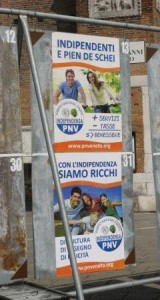
Schei is an old Venetian word from the period between 1797 and 1866, when the Austro-Hungarian Empire ruled the once-independent Venetian Republic. There was an Austrian coinage called “Scheidemunzen” (a generic term indicating that the coin was legally worth more than the metal it was made of), clearly a word that was born looking for a nickname. So the Venetians chopped off the first bit and pronounced it their own way. One scheo (SKAY-o) was one cent, that is, one one-hundredth of a Scheidemunze.
You will also still hear people use the term “franchi” to mean money. (If you were to earn some extra money, you’d tell your friends you’d “ciapa’ un franco,” grabbed some money, in the casual way we would refer to doing something on “my dime,” even if actually cost $40,000.)
The franchi don’t refer, as I once assumed, to francs circulated during the brief period when the French were the rulers here, but rather to the coinage of their successors, the Austrians. In that period there was another Austrian coin in circulation which carried the Latin name of the Emperor Franz Josef, i.e. Franciscus Iosephus. With the passion for diminutives that is one of Venetians’ more endearing traits, the money became “Franks.” So spending “franchi” would be like spending a batch of Abes or Georges today for the newspaper or a pack of gum.
While I’m off the track here, you also occasionally hear an older person refer to spending lombardi.
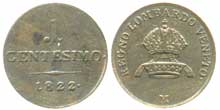
That goes back to the period of the Kingdom of Lombardy-Venetia (1815-1866), a sort of subset of the Austrian dominions about which I will tell you nothing more because life is short, but I will mention that Lino told me he has, somewhere in his impedimenta, at least one genuine lombardo. Very cool.
Venetians buy and sell in euros now, a word which is hopeless for fantasy, but it’s used here only in specific situations, such as paying the gas bill or pricing products. Peaches would cost four euros (not schei) a kilo, but the shopper would put them back because they cost “massa schei.” Too much money. But back to the budget.
How much money does Venice need to live on? And why does it keep coming up short? (And why do the lights blaze on all night on every floor of the Palazzo Balbi, in the offices of the Veneto Region??) The numbers, as reported in the press, don’t seem to match up, and studying the documents on the city’s website gave me the staggers, so I can only sketch some broad outlines.
As with any entity, the city has Income and Expenses. You need to increase (A) or decrease (B), or both, to keep going. Even I know that. And there has been a terrifying drop in (A) recently, the fiscal equivalent of the effect suffered by non-seat-belted passengers on a plane which suddenly hits one of those invisible air pockets. Furthermore, the world economic implosion has meant fewer tourists, and those who do come are spending much less.
Conversely, the increase in (B) has been relentless.
So while the larger world worries about water rising in Venice, the mayor is fixated on the ebb and flow of funds. That sound you hear is the city government squeezing 7 million euros out of this year’s budget. There’s plenty of pain to go around.
Income, some major sources of:
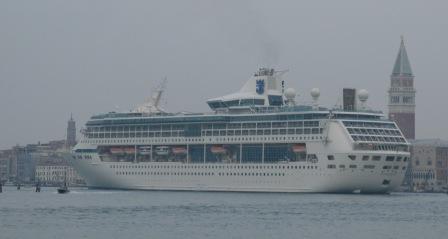
Expenses:
These are all the unromantic elements of keeping a city alive, if not well, and the budget has to cover not only the historic center of Venice, but its municipal partner, Mestre, which has its own particular problems. The struggle to resolve the very different demands of the two entities — dredge a canal or build a parking lot? — is never going to let up. But whereas people come to the historic Venice and spend money (and even respond to appeals for donations for same), it’s unlikely that the same amount of money would be forthcoming from appeals to help Mestre avoid becoming a souvenir. So there is tension. Unfortunately for historic Venice, Mestre has twice as many voters.
To sum up: The city budget currently shows 546 million euros in income, and the same amount in expenses. 467 million of those expenses are for operating costs: 134 million for personnel, and 79 million for the various departments. Welfare (a general term for various social costs) is 44 million. The police get all of 2 million. I won’t go on. Not much left over, as you can see, for the restoration of monuments and other more visible concerns of the most beautiful city in the world.
Mayor Massimo Cacciari could see trouble coming a year ago (even before the roof caved in on the economy of the Milky Way galaxy):
“TO SAVE VENICE REQUIRES 70 MILLION EUROS,” the Gazzettino headline read, beginning its report on the mayor’s unproductive trip to Rome, where he discovered that the Special Law had allocated Venice a mere 5 million for 2009. This is depressing, not only in itself, but because in a situation this dire, the need for money will tempt the city to give all sorts of waivers and exceptions and permissions to do things which are prohibited by various laws. The wild call of the schei, especially when it’s looking for a mate, is more unnerving than the cry of the migrating sandhill cranes at dawn.
“I explained to the Ministers that Venice needs annual refinancing of at least 60 million euros on the basis of the Special Law,” Mayor Massimo Cacciari said at the subsequent press conference. “Otherwise it will be difficult to guarantee — on the contrary, they could be blocked — projects tied to the maintenance of the city, of the dredging of the canals, to the restoration of the private buildings of the patrimony, to interventions for the socio-economic revitalization of the city, to the restructing of the government buildings.”
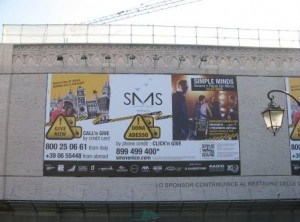
Anyone who has seen the swarms of summer tourists naturally assumes that they are all thickly padded with money, but this is not the case. On the contrary; tourism imposes more demands on maintenance (money out) than it gains from its wildly assorted visitors, most of whom — the merchants confirm — carry very little spare change these days.
Over time, the city has hazarded various proposals to increase income (and limit the number of tourists at a time, thereby controlling the maintenance problem, at least somewhat). One idea was to charge one euro from each tourist who stayed overnight (most tourism is of the “bite and run” sort, as they put it). This raised shrieks from the hoteliers, who saw it as punitive to the very people who were already actually spending money in the city. Another idea that keeps coming up is to sell an admission ticket to the city, but apart from conflict over its philosophical justification, no one has yet come up with a way to actually make it work.
So “Let’s find a sponsor” has probably surpassed “Let’s have a drink” in frequency, if not in popularity. Last year the mayor was wooing the German government for money; the movie stars who attended the Venice Film Festival were snagged as spokespeople more or less soliciting contributions; Elton John donated a bit of his music as a cell phone ringtone, the proceeds of which would go to the city.
Certainly something is better than nothing, but many of these maneuvers do have a sort of tin-cup aspect to them.
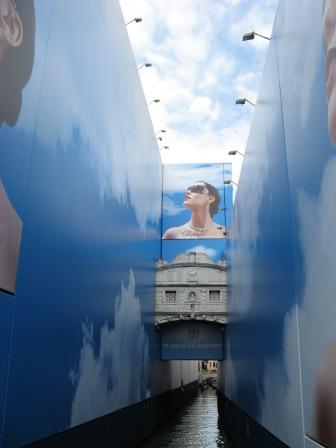
Then there are billboards, another form of sponsorship. The most overwhelming at the moment are in the Piazza San Marco area, covering the facades of the Marciana Library, part of the Doge’s Palace, the Bridge of Sighs, and the New Prisons. The aesthetic impact of these monstrous advertisements blatantly contradicts the notion that the sponsor is paying because he/she/it is sensitive to beauty and historic value. The cost of restoration has increased, and the funds have shrunk, to the point where these swathes of space are now regarded as the perfect commercial space for rent. Not a revolutionary idea in itself, but pretty subversive in a town which is also a UNESCO World Heritage Site.
There is one more aspect of the budget situation here that requires mentioning, and that is the Parris-Island-obstacle-course which an entrepreneur with a good idea has to attempt to run, from bureaucracy to high taxes to entropy, all exacerbated by the normal political parry and thrust which require time and attention too.
One such entrepreneur is yacht broker Stefano Tositti, director of BWA Yachting, and he maintains that there is much more to be earned from the luxury-yacht business than has yet been asked. “Luxury yachts is a sector that brings Venice about 10 million euros,” he told the Gazzettino; “it’s a lot of money when you consider that the work focuses on only 15 moorings used mainly in the summer. It’s not enough. There needs to be a marina adapted to the needs of people who come to Venice; here we’re not able to furnish certain services which our clients normally expect.”
In 2008, 173 of these peerless vessels adorned the embankments at the Punta della Dogana, the Riva dei Sette Martiri, and the Riva San Biagio. Some of these berths can cost 10,000 euros a day, presumably for mega-yachts such as Paul Allen’s “Octopus”
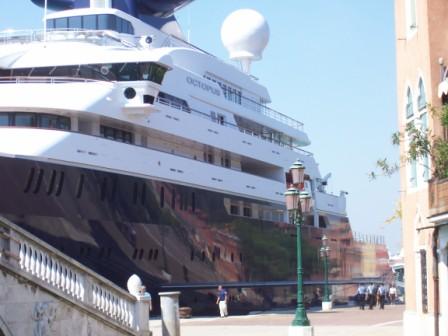
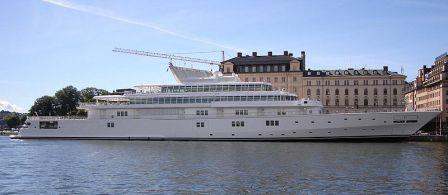
Larry Ellison’s “Rising Sun,” and Barry Diller’s “Eos,” the world’s largest sailing yacht, all of which put in to Venice from time to time. In the case of “Rising Sun,” it’s not easy to find berths it will fit into.
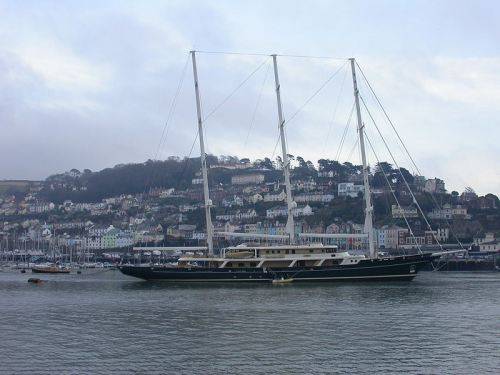
Tositti says that there are investors ready to support a marina project, and that an investment of 250 million dollars could bring earnings of 30 per cent within five years. He claims that the city could earn another 10 million euros if there were a structure for off-season storage. “The problem here is unfortunately bureaucracy,” he told the Gazzettino. “It seems as if the city doesn’t want to pay any attention to this niche market. In fact, very few berths are dedicated to this type of boat — there are very few services for yachts in general, and marinas are completely lacking in the historic center. ”
Happily, on July 2 it was reported that Moody’s had reviewed Venice’s books and awarded the city a rating of AA2, which is just below AAA and AA1. It is heartening to see that the city’s finances still pass muster. But with an eye on the drop in income from the Casino, Moody’s has also given Venice a friendly heads-up.
It appears that, at least for the near future, the margin between money made and spent in Venice will continue to be so narrow that you couldn’t even slip the average “suspension of service” notice through it. Yet still, schemes are proposed from time to time, such as the idea (since abandoned, or at least not mentioned) of installing turnstiles on all the vaporetto docks, which the city inexplicably is able to afford. This kind of maneuver only deepens the chasm between fiction and fact in this fairytale city. Yesterday the city couldn’t afford to pay more ambulance drivers, yet somehow money has materialized to install turnstiles?
It doesn’t do to dwell on these things. They only make you tired and unhappy.
###articles###
Esodo. (EH-zo-do.) It means “exodus,” but this simple term — like “Fort Sumter” or “potato famine” — is freighted with history and emotion.
When a Venetian refers to the Esodo, he or she is referring to a Gordian convolution of elements of which the Mother Strand which is knotting up everything else is this: Everybody’s leaving. Not all at once, obviously, but at a fairly steady rate of 1,500 a year. This has been going on for decades.
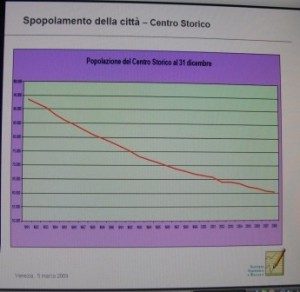
In 55 years (1951-2006), the “historic center” (“postcard Venice,” as I put it) has lost 65 percent of its population. It shrank from 171,808 residents to 63,925. At this writing, the population is 60,311 and still falling. I’ll pause to let that sink in.
If “exodus” seems to be a dramatic word, calling to mind haggard refugees plodding toward the horizon, the reality it connotes is not less dramatic, and potentially fatal to the city’s future. “‘Save Venice’ is passe’,” professor Fabio Carrera, a Venetian, told me, only slightly in jest — ” We need ‘Save the Venetians.'”
The reason the city doesn’t look like the desolate wasteland it is becoming is partly because the casual visitor doesn’t miss what he/she/they never knew. If you’re just walking around for a day, everything looks fine. Self-suggestion is a powerful force, and if you believe that Venice is inhabited by Venetians, you probably won’t notice much to contradict that idea, even though it’s mostly tourists who are filling up the empty spaces, both on the streets and in the apartments.
Economic pressures generated and intensified by the steady increase in tourism (3 per cent a year, till this year), have conspired to cause something resembling forced migration. Venetians have been packing up and moving out for many reasons: Lack of jobs here (businesses closing, even as you read this, due to rents which keep rising, and competitivity which keeps falling), the exaggerated cost of housing, the general cost of living, and even the nature of ordinary daily life (“fatiguing,” demanding,” “inconvenient,” even diehard Venetians will admit).
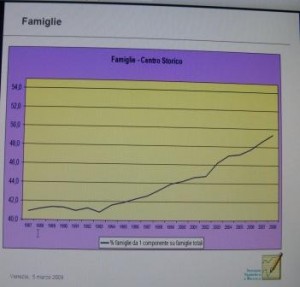
To consider each of these points more closely, let’s look at the last first. Living in Venice, beautiful and fascinating as it may be, is not for everyone. Living here is a vocation, like being a priest, and it too involves sacrifices (and rewards). Considering how heavy — and even impossible — some of those sacrifices have come to be, I can understand why the city can’t keep its kids at home. Not everyone wants to walk five miles a day shlepping the shopping, wedging themselves and their kids onto vaporettos crammed with tourists and their inconceivable luggage, paying prices for even the simplest items which you know cost half as much on the mainland.
Leaving Venice — apart from being carried out in a pine box — has usually meant a move to the mainland towns. First it was Mestre and Marghera, then the territory of Venetian exiles expanded to a series of smaller sub- and exurbs such as Zelarino, Chirignago, and Favaro Veneto. I think of it as Venice’s “near abroad,” the way Russia refers to its former republics. Except some of these settlements were mere wide spots in the country roads winding through fields till the Esodo began.
Mestre and Marghera have been part of the municipal entity known as the Comune di Venezia since 1926. In 1951, the proportion of inhabitants between Venice and its mainland component was 55:21. In 2006, it was 23:66.
Second point: Cost of housing and of living. Here again, the pressure of tourism works against the city’s ultimate well-being (as a city, I mean, not as a theme park). There is very little residential space for rent (for many reasons, one of which is laws which heavily favor the tenant), and the passion which non-Venetians have for buying a place here has led to phenomenal real estate speculation, pushing prices so high a normal Venetian can’t even spell them, much less pay them. The Giudecca has replaced Tuscany as your well-off Briton’s favorite Italian place for a second home.
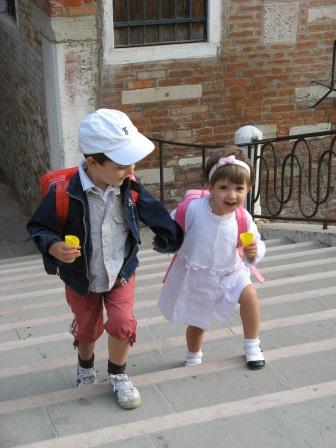
Depending on the neighborhood, a modest dwelling can cost up to $5,000 per square meter (or 10 square feet). For the same amount of money (assuming you might have that much), or even less, you could get a place on the mainland that was multiple times larger, in better condition, with an elevator, and a garage, and a garden, and so on. If you’re a young family on a budget, you’re going to delete “romance” from your list of domestic requirements and go west.
And finally, the first point: Lack of jobs. Until the middle of the last century, Venice was a city that worked. The Arsenal was still going strong, repairing ships; the colossal Molino Stucky was making pasta, from grinding the wheat to boxing and shipping the final product; there were 20 printing presses; there were factories in Venice and on the Giudecca making cigarettes, cotton thread, asphalt, clocks, pianos, fireworks, beer, and luxury fabrics. I’m probably leaving something out. If you needed work, you’d have had to stay in bed to avoid finding it.
The cost of everything has not only forced out families, but also businesses. They keep closing, or moving, taking their jobs with them. Now, some 20,000 people commute to work on the mainland every morning.
So while “esodo” is what everybody calls it, I’d compare it more to a Class III hemorrhage, caused perhaps by several events but which, taken together, damage the vital functions and left unaddressed will probably kill you.
I know a number of ex-residents — they would still call themselves “Venetians” — who have moved to Mestre. (If you’re a native of Mestre, you’re referred to as a “Mestrino/a.” If you go anywhere outside the Veneto region, though, you will almost certainly tell people you’re from Venice. Technically, it’s not a lie, but your listener will be imagining you in a gondola and not stuck in traffic on the way to the airport.)
The older these exiles are, the less willing they were to make this move. One of them, a guy I know who belongs to a boat club over there, makes a point of rowing over here with his buddies as often as he can.
They stopped in the canal outside one afternoon and rang my doorbell. We had a little schmooze, but he ignored his three companions’ pleas to get going because he had to — HAD TO — show me something. Because his grandparents used to live in our building, and when he was born — he dragged me around the corner — his grandfather immediately took him to this very canal (he showed me the very steps going down into the very water) and dunked him three times. “This red bandanna,” he pointed to his neckerchief, “means I’m from Castello.” His friends were rolling their eyes, but to him it was something utterly crucial about him, about the city, about the world the way it used to be, a world that doesn’t and can’t and won’t ever exist on the mainland.
I’ve met ex-Venetians who come over from Mestre on Sunday afternoon just to stroll around, just to be here. Like going back to the old home place. On a personal level, it is pure pathos, which doesn’t primarily mean “sad,” it means “suffer.” I don’t know if I’ve ever heard a transplanted Venetian say, “Life is so much better since we left Venice.” I have heard some say, “We really, really miss it.” The emotional reality of this erases much of the importance of factors such as cost of living, crowded vaporettos, and all those other drawbacks I mentioned above.
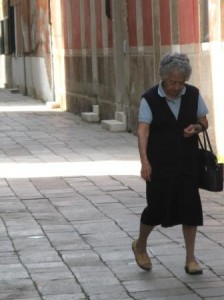
The city government is not oblivious to what’s going on. There are spasmodic attempts to get a grip on some appendage of this monster, and a recent recalculation shows that the departures have slowed, if not stopped. New apartments built or renovated to be made available at advantageous prices to Venetians was an excellent idea, then it was discovered that there were Venetians buying them in order to re-sell them. Jobs? Nobody seems to know where more might be found. I think I saw one around here the other day, but I can’t remember where.
I sometimes wonder what it would be like to be the mayor of Venice and go abroad to some big international conference of mayors. And someone asks, “So, how are things in your city?” (I overlook his probable first response which would be “Fine, except that the people are morons.”) I imagine him saying “Fine,” period. Or maybe, “Well, could be better.” Or maybe, “We’re evaluating some exciting new projects,” or however mayors phrase it.
It would be much harder to have the nerve to admit, “There are a lot of great things about my city, except that nobody can live there. I’m mayor of a city in which it is becoming literally impossible to live.” What response could anyone give to that statement? It would be like asking a ship’s captain about his vessel and hearing him say, “She’s in great shape, except for that large hole in the hull.” Nor would it make much sense for him to say, in effect: “Hey! At least we’re still floating!”
It bears some thinking about. In fact, now that this radical thought has occurred to me, it’s going to be bothering me a lot.
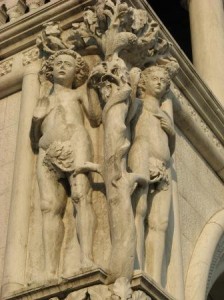
On Saturday a moderately publicized event was staged here which was billed as the “Funeral of Venice.” It was organized by a local group/social site called venessia.com. (This is the way Venezia is spelled in Venetian. Disclosure: I’m signed up but I hardly ever visit.) I didn’t attend but I was aware of the drumbeats leading up to it and cast my eye over the assorted coverage in its wake.
The event consisted of loading a fuchsia-tinted casket onto a six-oar balotina and carrying it, followed by a sort of funeral cortege of boats, down the Grand Canal from the train station to Ca’ Farsetti, or City Hall, by the Rialto Bridge. There was also an enormous floral wreath with the traditional ribbon from the bereaved donor: “Venetian Citizens,” it read.
The casket was carried into the atrium and a sort of funeral oration was declaimed. Then some people kicked the casket to pieces and a flag with the symbol of the phoenix (rebirth, hint hint) was taken out. At least they didn’t dig a grave somewhere out along the sidewalk and bury the thing. All this was moderately covered by the local press, it being Saturday and evidently a slow news day. But it was covered more extensively by the foreign press, perhaps being tired of covering the usual stories of death and dismemberment from around the world. So they came for a different story of death and dismemberment, the municipal variety.
The motivation for this moderately unusual gesture was to draw the world’s attention — or if not the world, the city government — to the fact that the population of the city had just dropped below 60,000. Of course the city government already knew that but didn’t interpret it in the same way as the protesters. I’m not sure the government interpreted it at all.
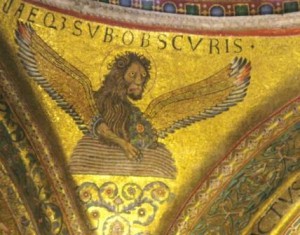
What’s so significant about 60,000? Because this is the number at which a settlement is defined as a “city.” Therefore, having fewer, Venice has now become a town. After which a village, I suppose, then a hamlet, then a hermit’s refuge.
“The city doesn’t want to resign itself to becoming a modern Pompei,” said actor Cesare Colonnese as part of his oration, to the assembled multitude of foreign reporters — according to the Gazzettino, there were four taxis full of journalists, and a barge with somebody playing the piano. “Danse Macabre” would have been a good choice. (Actually he was playing “Funeral March” by Chopin.) All in all, the account as given sounds more like something concocted for Carnival than anything else. Needless to say, no politicians showed up.
At a mere two days’ distance it’s hard to make a judgment on the impact this event might have had on public policy and the future of the city. If discernible, it too would be moderate, I’d guess. It mostly had the aroma of the sort of wailing and gnashing of teeth that goes on here for almost any reason you can come up with, said wailing and gnashing being totally justified and virtually always ineffective. And not really all that satisfying, I believe, because like anything else it can become a habit and therefore loses much of its pleasure.
In any case, the city government has never responded to wailing and gnashing. Where mere citizens (and not economic sectors) are concerned, it is wail- and gnash-proof.
Lino, who belongs to the class — Venetians born and bred — which some believe ought to be first on the barricades, was massively uninterested. Not that the fate of his city doesn’t interest him, but scenarios like the casket seem to come with futility and foolishness already installed, making them useless for any serious work that has to be done.
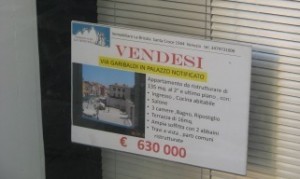
First of all, he noted that of the people who responded, a large contingent were foreigners. No disrespect intended, but when a call to arms, however well-meant, comes more from without than within, it’s a symptom that something is already out of kilter. If the city government doesn’t respond to its own citizens, who presumably have a long-term stake (fancy way of saying “pay taxes”), it’s unlikely that it will respond to those who mostly don’t.
But the story is simpler than all this. Lino ran me through it:
“A lot of the Venetians who moved to the mainland used to live in cellars,” he stated. Venice doesn’t have cellars, but it’s as close as I can come to the real word he used — magazzini — those humid, moldy street-level areas never intended as dwellings because of their propensity to flood, but which are universally useful as storage space for anything that isn’t bothered by humidity or mold. But people lived in them all the same because they didn’t have anywhere else — this large cohort not being nobility, obviously, or even the middle class, but what once was a large working class and whoever is below that.
Many Venetians of his era –say, from before World War II to something like ten to 15 years after it — remember how much miseria there was. “Miseria” is a very useful word because it not only connotes poverty, but everything physical and emotional that goes along with it, which could also be called “misery.” A friend of mine remembers the family that lived upstairs, who sometimes came down to their apartment to get warm. His mother would occasionally give them meat. He remembers houses that smelled of “cold ashes.”

“It was a dirty, provincial, poverty-stricken backwater,” Time magazine noted in a review of an exhibition in 1936. The unnamed reporter was referring to the city in the 18th century, but not so very much had changed by the 20th. In 1900 a cholera epidemic broke out; not difficult in a city surrounded by water, but a classic threat to those weakened by malnutrition and general crud. “Death in Venice” was written not long afterward(1911), and although the title reeks of romance, the death itself merely reeks. It was cholera, a disease which has no aesthetic component whatever even if the protagonist was staying in a fancy hotel on the Lido.
In reporting on the 1836 epidemic, a British medical journal said this: “The proportion of cholera patients in the poorest to those in the wealthiest parishes in Venice is 100 to 15,” it stated. People who were especially susceptible were “persons of irregular habits and diet… using bad food…affected with chronic complaints…poor…over-worked…dirty.”
Lino remembers children with lice, scabies, typhus. Not that the city was some huge slum, but it wasn’t exactly an autoclave, either.
“When people got the chance live in something better, of course they took it,” he went on.
It’s common knowledge now, as it has been for decades, that the cost of real estate in Venice is fabulously high and just keeps going higher. So if anybody had the slightest opportunity to trade up, they took it.
“For what they would pay for a small magazzino here, they could get a big apartment on the mainland, with a garage and garden and elevator and everything.” But they didn’t count on the emotional element, and he says that many of these transfers had the chance to come back, they’d do it in a flash.
So why don’t they?
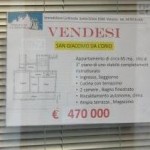
“The plain fact behind all this is that the cost of real estate has now reached a level which is unattainable for most people,” he said. “And don’t forget” — here it comes — “it’s also Venetians who are the cause. If someone has an apartment to sell, he’s obviously going to put the highest possible price on it. A price which only a foreigner could pay, even if they only come here a few days or weeks of the year. Just walk around — there are so many houses that are shut up.”
This is true; it’s not uncommon for people to ask me what’s up with all the closed shutters.
Venetians, knowing all this, are at a loss to find a handhold on the situation. But this Saturday-morning ceremony was a worthy attempt and it did make for a moderately dramatic interlude at City Hall. The city intermittently devises some new plan to address this situation, but as they say here, “The law is made, the loophole is found.” A number of those new apartments on the Giudecca a few years ago that were supposed to be reserved for Venetians? Certain conditions weren’t imposed on the terms of sale, so Venetians were buying them — and then reselling them at inflated prices.
The Councilor for Housing, Mara Rumiz, had the grace to hold a press conference at which she discussed some initiatives to confront the housing situation. I feel that ought to be acknowledged.
Cesare Colonnese, an actor who gave the discourse, had this to say on his website (in Italian and at the end in Venetian): “…I don’t want to get into discussing politics and I don’t know if talking about responsibility is always correct. I think in this case the responsibility should also be on the part of all of us. It’s also up to us to do something for Venice, it’s also up to us to set a good example…. We Venetians shouldn’t always present ourselves as complainers and never content. Each one of us, from the artisan to the glass-maker, from the baker to the pizza-maker, has a craft in his hands and the potential to show themselves and others that Venice is a strong city that’s capable of being reborn. Venice doesn’t have to lose its characteristics and traditions. We have to raise our children teaching them to love these customs and traditions because they will be the future of this city [Note to Cesare: Are you going to stem the mania for celebrating Halloween here, which nobody has any idea what it is except some new fad the kids insist on pursuing? I’d vote for starting here with the old defend-our-traditions project]. It’s useless to leave with our tails between our legs, because by leaving we lose contact with this reality as well as, in my opinion, the right to complain. Who says that Venice is dead? It’s time to quit this talk while just sitting around. So get up! Get up! You too, go and do something!” Like what? SOMETHING. I’ll get right on it!
The Gazzettino reported a smattering of comments across the spectrum of onlookers. One 70-year-old Venetian man said, “Nobody has worked right down to the bottom on the issue of residentiality for Venetians,” he said. “We need to bring Venetians back to the city and this should be the work of a good administration.” Affordable housing, in two words.
“I think it’s silly,” remarked a young Venetian woman who moved to Mestre. “I’d never move back to Venice. I come here to work, but it’s better to stay away from the city, which at this point has more disadvantages than luxuries.” Points for candor.
“I’d never have thought we could reach this point,” commented a retired grocer — “a demonstration about being able to live in Venice. I’d like to put the politicians in the casket.”
A jeweler who lives on the mainland thought it was a joke. “The destiny of Venice is the same as all the ‘art cities,'” he said. “It’s a world in evolution.” And in fact I have heard this from others — that many of Venice’s problems are also problems in Florence, and elsewhere. The residents are under siege wherever tourism has unhinged the economic equilibrium.
Well, at least this time the story about Venice sinking isn’t about water or tourists. What would it be sinking beneath? Just about everything except gluttony, although when the ceremony was over there were refreshments. As everyone is fond of observing, “All the psalms finish with the Gloria.” The happy ones, the tragic ones — whatever is going on, make sure you’ve got snacks. Oh, and drinks. They had Prosecco, naturally. No point in suffering needlessly.